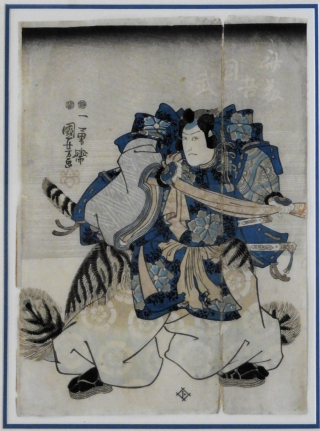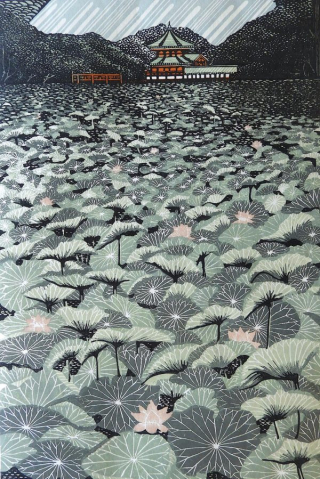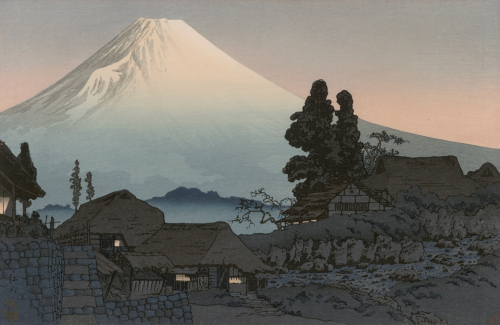The Visual Arts Collection holds a number of artworks by modern and contemporary Asian artists, including Abdur Rahman Chughtai, Haku Maki, Krishna Reddy, Ray Morimura, Raza Sayed Haider, Shotei Takahashi, and Utagawa Kuniyoshi.

Utagawa Kuniyoshi (1798-1861), one of the last great masters of the Japanese ukiyo-e style of woodblock printing and painting, was active in the 19th century in the city of Edo, present day Tokyo, during the repressive rule of the Tokugawa Shogunate regime. Despite severe state-sponsored censorship and restrictive laws, the arts flourished during this period, largely due to a growing class of artisans and merchants, dubbed “townspeople” by the Shogunate, who inhabited Japan’s urban centers.
Actor Ichikawa Kuzo II as Saitogo Kunitake pictures a kabuki actor portraying a warrior. Kabuki, a form of highly stylized Japanese theatre, was an entertainment of choice for townspeople, who were also the main consumers of woodblock prints. Kabuki actors, like the one represented here, were much like modern-day celebrities, making for ideal woodblock subjects. Here, the subject meets the viewer’s gaze directly, implicating him in the unfolding drama. This artwork is on view in the Visible Storage Gallery, on the 4thfloor of the McLennan Library.

Prints by contemporary Japanese artist Ray Morimura (1948-) are amongst the highlights of the Visual Arts Collection’s recent acquisitions. Less familiar to a Western audience than earlier Japanese prints, Morimura’s colourful and detailed renditions of Japanese landscapes are a great example of how a traditional process can be used today to make new and original images.
Shinobazu no Ike, from 2011, depicts a famous pond in Tokyo, the subject of many traditional Japanese prints. Morimura employs modern, geometrical patterns to represent natural and architectural elements. The intricate bundle of pale-to-dark green and soft pink water lilies creates depth, guiding the eye to the temple in the background, itself marked by a vivid orange-red.
Eight woodblock prints by Ray Morimura are currently on display on the 6th floor of the McLennan Library.

Takahashi Shōtei (1871-1945) studied art under the tutelage of Matsumoto Fuko, co-founded the Japan Youth Painting Society in 1889, and was one of the leading figures in the shin hanga movement, an important artistic trend of the early twentieth century that sought to revitalize traditional ukiyo-e art rooted in the Edo and Meiji periods.
The iconic profile of Mount Fuji, uncontested landmark of Japan and a veritable challenge for artists, has remained a popular theme amongst Japanese painters and printmakers for hundreds of years. Shotei Takahashi’s views of Mount Fuji are considered to be some of the best woodblock prints of modern Japan.

Krishna Reddy (1925-2018) was a printmaker, sculptor, and teacher from India. He received his Bachelor of Fine Arts from Visva-Bharati University in 1946 and later moved to Europe, where he worked with artists such as Henry Moore (1898-1986) and Constantin Brâncusi (1876-1957). Reddy is known as a pioneer of viscosity multicolour printing, a printing technique that uses the principle of viscosity to print multiple colours of ink from a single plate rather than relying upon multiple plates for colour separation.
Reddy is best recognized for his abstract works composed of multiple radiating and textured grid-like lines. This print is typical of his style. It features a strange human-like figure located in an abstract space and surrounded by an amalgam of fine lines that emulate movement.